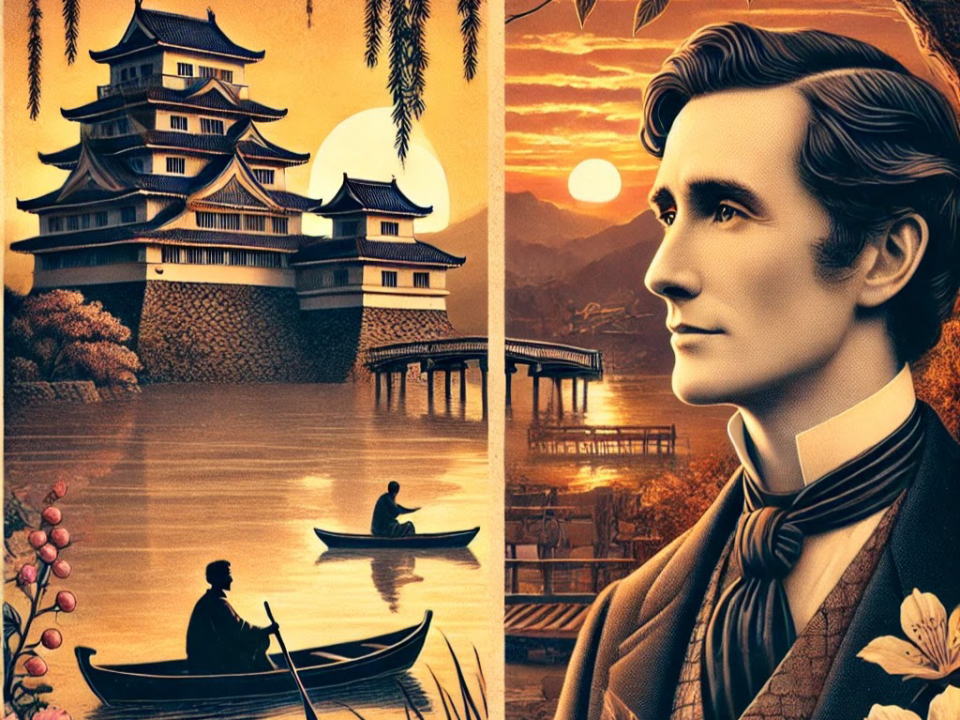
Lafcadio Hearn, known in Japan as Koizumi Yakumo, found a unique and profound beauty in Japan’s landscapes, culture, and daily life.
His works capture the charm of Japan through the eyes of a Westerner, and they continue to be cherished by many readers today.
So, what exactly was the "beauty of Japan" that Hearn saw?
The Beauty of Japan’s Natural Scenery
Hearn was deeply moved by Japan’s seasonal changes and landscapes.
One of the most unforgettable sights for him was the sunset over Lake Shinji in Matsue.
He once described Japanese scenery as different from that of the West, emphasizing how nature and human life harmoniously coexist.
He was also fascinated by the fleeting beauty of cherry blossoms falling and the vibrant colors of autumn leaves, recognizing in them the Japanese sense of impermanence—mujōkan.
His works depict these natural beauties with poetic expression, leaving a lasting impression on readers.
Japanese Architecture and Living Spaces

Unlike the stone buildings of the West, Japanese wooden architecture felt open and closely connected to nature.
Hearn was particularly captivated by elements like shoji (paper sliding doors), tatami (woven straw mats), and gardens, which created an atmosphere of tranquility and calm.
He greatly appreciated the way Japanese houses allowed light and wind to flow freely, seeing it as an intentional way for people to live in harmony with nature.
He once wrote, "Japanese houses are built so that wind and light can pass through freely.
This is a way for people to live together with nature."
Hearn’s former residence in Matsue remains preserved today as a symbol of his deep appreciation for Japanese culture.
The Heart of the Japanese People
What impressed Hearn the most was the spirit and values of the Japanese people.
He was deeply touched by the sense of courtesy and kindness in daily life, which he saw as fundamentally different from Western values.
For instance, he admired how children would greet people on the street and how hospitality was naturally ingrained in Japanese culture. He called this aspect of Japan "unseen beauty."
He was also fascinated by the strong family and community bonds.
Through his marriage to Koizumi Setsu and his interactions with her family, Hearn gained firsthand experience of Japan’s family system and Confucian values, which he later incorporated into his writings.
Japanese Traditions and Folklore
Hearn had a deep interest in Japanese traditions and folklore, particularly ghost stories and supernatural legends.
He collected and adapted many stories into his book Kwaidan, not just as frightening tales but as reflections of Japan’s spiritual beliefs and attitudes toward life and death.
He was especially drawn to stories like Yuki-Onna (The Snow Woman) and Mimi-nashi Hoichi (Hoichi the Earless), in which he saw expressions of Japan’s reverence for ancestors and the supernatural.
Additionally, he was fascinated by Japanese festivals, shrines, and temples, seeing them as places where spiritual traditions naturally blended into everyday life.
Conclusion
The beauty of Japan that Lafcadio Hearn saw was not just in its landscapes or architecture but deeply rooted in its people and cultural traditions.
Through Japan’s seasonal beauty, delicate craftsmanship, warm-hearted people, and deep-rooted traditions, Hearn discovered a profound aesthetic that resonated with him.
His works continue to allow us to see Japan through his eyes, offering a fresh perspective on its timeless charm.
References
- https://www.hearn-museum-matsue.jp/ (Lafcadio Hearn Memorial Museum)
- https://www.kankou-matsue.jp/ (Matsue Tourism Official Site)
- https://www.jnto.go.jp/ (Japan Government Tourism Agency)
